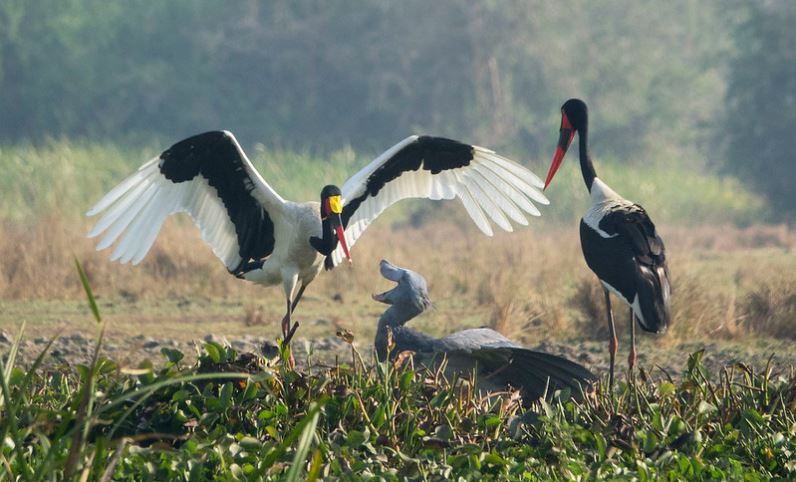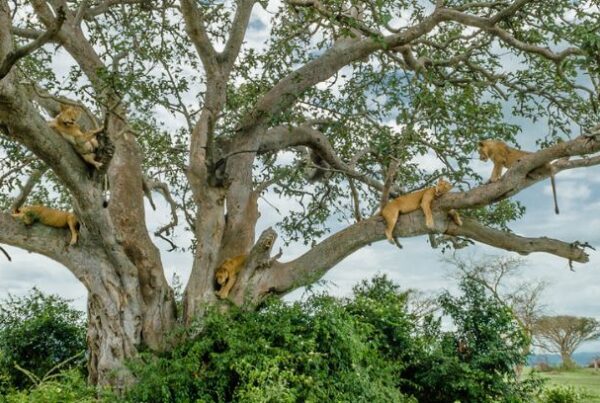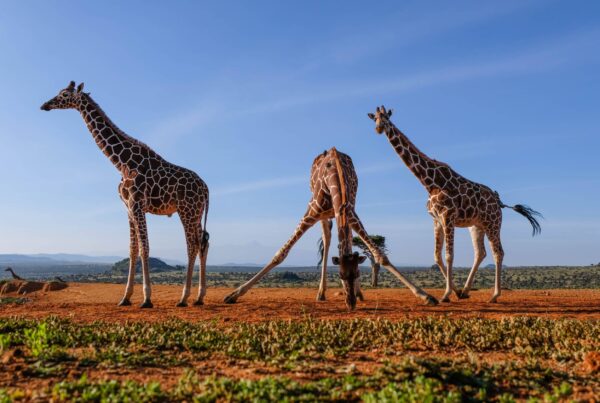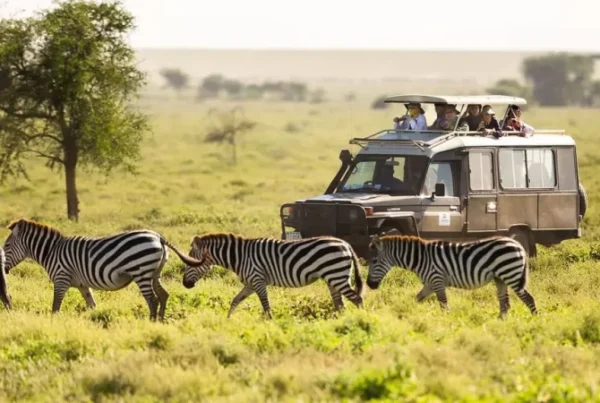Birding Safaris in Murchison Falls National Park
A Symphony of Wings and Songs in the Wild
Few places in Africa capture the imagination of bird lovers as vividly as Murchison Falls National Park, Uganda’s oldest and largest protected area. This vast wilderness, where the mighty Nile River thunders through a narrow gorge before spreading across savannahs, woodlands, and wetlands, is not only celebrated for its dramatic landscapes and abundant big game but also as one of the finest birding destinations on the continent.
Birding safaris in Murchison Falls are an invitation to enter a world alive with color, sound, and movement. It is a journey that goes beyond the typical safari encounters with lions, elephants, and giraffes, and immerses travelers into the delicate and fascinating lives of over 450 recorded bird species. From the rare and prehistoric-looking shoebill stork lurking in papyrus swamps to the dazzling flocks of bee-eaters along the riverbanks, every corner of Murchison offers a fresh discovery for those who walk with binoculars and a sense of wonder.
This article explores in depth the experience of birding in Murchison Falls National Park. It examines the geography and ecosystems that make the park a haven for avifauna, describes the iconic species found within its boundaries, details the various birding habitats, and explains the best times and ways to embark on a birding safari. It also highlights the conservation significance of birdwatching and the profound impact such an activity can have on the appreciation of Uganda’s natural heritage.
The Landscape and Ecology of Birding in Murchison
Murchison Falls National Park stretches across 3,840 square kilometers, making it the largest protected area in Uganda. Its diverse landscape is the foundation of its extraordinary birdlife. The park is bisected by the Nile River, whose journey through the dramatic Murchison Falls gorge defines the region’s character.
The northern sector is dominated by expansive savannah grasslands and open woodlands, habitats that attract ground-dwelling and raptor species. To the south lies a mixture of dense forest patches and riverine woodlands, where forest-specialist birds thrive. Along the riverbanks, the wetlands, swamps, and papyrus stands form ideal nesting and feeding grounds for aquatic and semi-aquatic birds.
This mosaic of ecosystems ensures that the park supports an astonishing diversity of species. It is one of the few places where forest birds, waterbirds, and savannah specialists can be observed in a single safari. For birders, this means that every excursion, whether by boat, vehicle, or on foot, holds the promise of uncovering new species, some of them rare or even endemic to this region of Africa.
Iconic Bird Species of Murchison Falls
The birdlife of Murchison Falls is a tapestry of the common, the spectacular, and the elusive. Among the most sought-after species is the shoebill stork, a prehistoric-looking bird with a massive shoe-shaped bill and a reputation as one of Africa’s rarest and most fascinating avian sightings. Found in the papyrus swamps of the delta where the Nile meets Lake Albert, the shoebill has become an emblem of birding in Uganda.
The park also shelters the Goliath heron, the largest heron in the world, often seen stalking the riverbanks with majestic composure. The Abyssinian ground hornbill, with its striking black plumage and vivid red facial skin, strides across the savannah in pairs, while the African fish eagle, with its piercing call and bold contrast of black, white, and chestnut feathers, is almost always present near the Nile.
In addition to these, Murchison boasts an abundance of kingfishers, bee-eaters, weavers, sunbirds, and raptors. The forested southern sector shelters species such as the white-thighed hornbill and the chocolate-backed kingfisher, while the open northern plains attract Denham’s bustard, black-bellied bustard, and flocks of helmeted guineafowl. For migratory bird enthusiasts, the park is also a seasonal host to numerous Palearctic migrants, adding a dynamic layer to its avifaunal diversity.
The Birding Habitats of Murchison
Riverine and Wetland Birding
The Nile River is the lifeline of the park and one of its richest birding habitats. Along its banks, flocks of red-throated bee-eaters carve their nests into sandy cliffs, creating vibrant colonies that dazzle with their synchronized flights. The river also provides opportunities to see waterbirds such as the African skimmer, cormorants, darters, and a variety of herons and egrets.
The delta area near Lake Albert is particularly rewarding. This is the prime habitat for the shoebill stork, where patient scanning of the papyrus edges often reveals this extraordinary bird standing motionless in search of lungfish. The wetlands here also support jacanas delicately stepping across floating vegetation, as well as whistling ducks and other aquatic species.
Savannah and Woodland Birding
The northern sector of Murchison, characterized by rolling savannahs and acacia woodlands, is excellent for spotting ground-dwelling birds and raptors. Large terrestrial species such as bustards, francolins, and the Abyssinian ground hornbill are frequently seen. Raptors such as the martial eagle, bateleur eagle, and African harrier-hawk soar overhead, while weavers and finches decorate the acacia trees with their elaborate nests.
The open landscape also makes birding highly rewarding because sightings are rarely obstructed, and the birds are often observed in clear view against the backdrop of grazing antelopes and roaming elephants.
Forest Birding
In the south, the Budongo and Kaniyo Pabidi forests form a contrasting birding environment. These semi-deciduous forests shelter species that are rarely encountered in open habitats. Here, birders may encounter the yellow-footed flycatcher, Nahan’s francolin, and a variety of hornbills and turacos. The dense canopy, although challenging, creates a sense of intimacy with the forest, where patient listening and careful observation often lead to remarkable discoveries.
Birding on Boat Safaris
One of the most distinctive ways to experience birding in Murchison Falls National Park is by embarking on a boat safari along the Nile. These excursions offer the rare chance to observe birds at close range while gliding through the river’s calm waters. The boat trips usually travel either upstream towards the base of Murchison Falls or downstream towards the delta at Lake Albert.
On the upstream journey, the cliffs and rocks host colonies of bee-eaters, while kingfishers dart across the water and herons patiently stalk fish along the edges. The boat also allows access to the dramatic setting of the falls themselves, where raptors can sometimes be seen circling in the thermals above the gorge.
The downstream trip to the delta is a birder’s dream. It is here that the elusive shoebill is most reliably seen, often alongside saddle-billed storks, open-billed storks, and squacco herons. The combination of aquatic life, dramatic landscapes, and bird activity makes the boat safari a highlight of birding in Murchison.
Birding on Game Drives
For those who prefer traditional safari vehicles, birding during game drives across the northern sector offers excellent opportunities. While the primary focus of these drives is often on mammals such as lions, giraffes, and elephants, the abundance of birdlife ensures that birders remain constantly engaged. The savannah plains, punctuated by borassus palms and acacia trees, serve as prime perches for raptors and songbirds alike.
Game drives are especially rewarding in the early morning and late afternoon, when birds are most active. With the guidance of experienced rangers, visitors can easily combine big game viewing with focused birdwatching, creating a multifaceted safari experience.
Walking Safaris and Intimate Encounters
In addition to vehicle and boat-based experiences, walking safaris offer an even more intimate birding encounter. Accompanied by guides and rangers, visitors venture into the woodlands and along riverine paths, where smaller species can be observed at close range. The slower pace of walking allows birders to listen more carefully, track specific calls, and appreciate the details of plumage and behavior that might be missed from a vehicle.
Walking also provides a sense of connection with the environment, where each bird sighting becomes part of a broader appreciation of the textures, scents, and sounds of the African wilderness.
The Best Time for Birding Safaris
Birding in Murchison Falls is productive throughout the year, but the experience varies with the seasons. The dry months, from December to February and from June to September, are often preferred because the trails and roads are more accessible, and many species are more easily seen around water sources.
However, the wet seasons, between March and May and again in October and November, bring their own unique rewards. During these months, the park becomes lush and green, and many resident birds enter their breeding seasons, displaying vibrant plumage and elaborate courtship behaviors. Migratory species from Europe and Asia also arrive during this period, adding to the diversity and excitement.
Thus, the best time depends largely on the preferences of the birder. While the dry season offers convenience and clearer sightings, the wet season provides the thrill of seeing the park at its most vibrant and dynamic.
Conservation Value of Birding Safaris
Birding safaris in Murchison Falls are not merely recreational. They play a crucial role in conservation and sustainable tourism. Birdwatching attracts a specialized type of traveler who values nature deeply and contributes directly to the funding of protected areas. The revenue from birding permits, park entry, and guided activities helps sustain conservation initiatives that protect both birds and other wildlife.
Moreover, birding creates awareness about the fragility of ecosystems. Observing the delicate balance that supports the shoebill stork, for instance, emphasizes the importance of conserving wetlands, which in turn support countless species of fish, plants, and local livelihoods. In this way, birding becomes a tool not only for enjoyment but also for advocacy and stewardship of nature.
The Transformative Experience of Birding
For many travelers, birding in Murchison Falls is more than a checklist activity; it is a transformative journey that deepens the connection with the natural world. Watching the synchronized flight of bee-eaters, hearing the call of a fish eagle at dawn, or witnessing the patient stillness of a shoebill evokes emotions that transcend simple observation.
Birding also teaches patience, attentiveness, and humility. It invites visitors to slow down, to notice the subtle details, and to appreciate the richness of life that exists beyond the more obvious attractions of the African wilderness. In doing so, it transforms the safari into an experience of learning, reflection, and wonder.
An Invitation to Discover
Birding safaris in Murchison Falls National Park are among the most rewarding experiences available to travelers in Africa. They combine the thrill of discovering rare and iconic species with the beauty of diverse habitats, the excitement of multiple safari styles, and the satisfaction of contributing to conservation. Whether one is an expert ornithologist or a beginner inspired by the colors of a sunbird, the park offers endless opportunities to be amazed.
To make the most of this extraordinary adventure, it is recommended that travelers plan their birding safari with WildHorn Africa, a trusted tour operator dedicated to creating seamless and enriching journeys across Uganda. With expert guides, personalized itineraries, and a commitment to responsible tourism, WildHorn Africa ensures that every birding safari becomes not just a trip but a story worth telling, a memory worth cherishing, and a connection worth preserving.





 WildHorn Africa – Authentic and unforgettable tours across Africa, guided by local experts who know the land, wildlife, and culture best.
WildHorn Africa – Authentic and unforgettable tours across Africa, guided by local experts who know the land, wildlife, and culture best.


